To master temperature control in your off-grid kitchen, you'll need to combine both solar and traditional cooking methods strategically. Position your solar cooker between 11:00 AM and 3:00 PM for ideal sun exposure, using matte black cookware for better heat absorption. You can achieve temperatures up to 550°F with parabolic cookers and 325°F with box cookers. Adjust your cooking surface angle to match your latitude, and realign every 20-30 minutes to track the sun. For year-round success, incorporate wood stoves during winter months and use insulated cookware with windbreaks to maintain consistent heat. Understanding these foundational principles will free up even more advanced temperature control techniques.
Understanding Solar Cooking Heat Patterns

While traditional cooking methods rely on fuel combustion, solar cooking harnesses the sun's energy through an elegant interplay of reflection and absorption.
You'll find that different solar cooker designs create distinct heat patterns: parabolic models concentrate sunlight to a single point, reaching temperatures above 550°F, while box cookers maintain steady temperatures up to 325°F.
Your cooking success depends on timing and positioning. You'll achieve the best results during the two hours before and after solar noon when the sun's energy is most intense.
For maximum heat absorption, use matte black pots and pans, and guarantee your cooker maintains proper alignment with the sun. Thermal coatings like activated-carbon-coated aluminum can dramatically improve your cooker's performance.
Remember that factors like wind, air temperature, and nearby shadows can affect your cooker's performance, so you'll need to monitor and adjust accordingly.
Positioning Your Solar Cooker
Successful solar cooking begins with strategic placement of your cooker to maximize sun exposure. Position your cooker between 11:00 AM and 3:00 PM when the sun's intensity peaks, or start an hour earlier during winter months. For optimal performance, adjust the cooking surface at an angle equal to your latitude.
You'll need to adjust it every 20-30 minutes to track the sun's movement.
Set up your cooker on a dry, level surface, using bricks or stones for stability on windy days. Orient the shorter front panel eastward for noon meals or westward for evening cooking.
Check the shadow behind your cooker to confirm proper alignment with the sun. Keep the cooking area away from potential shade sources and use wind barriers when needed.
Don't forget to secure the front panel's flaps with clothespins and maintain a wire rack underneath your pot for better heat circulation.
Seasonal Temperature Adjustments
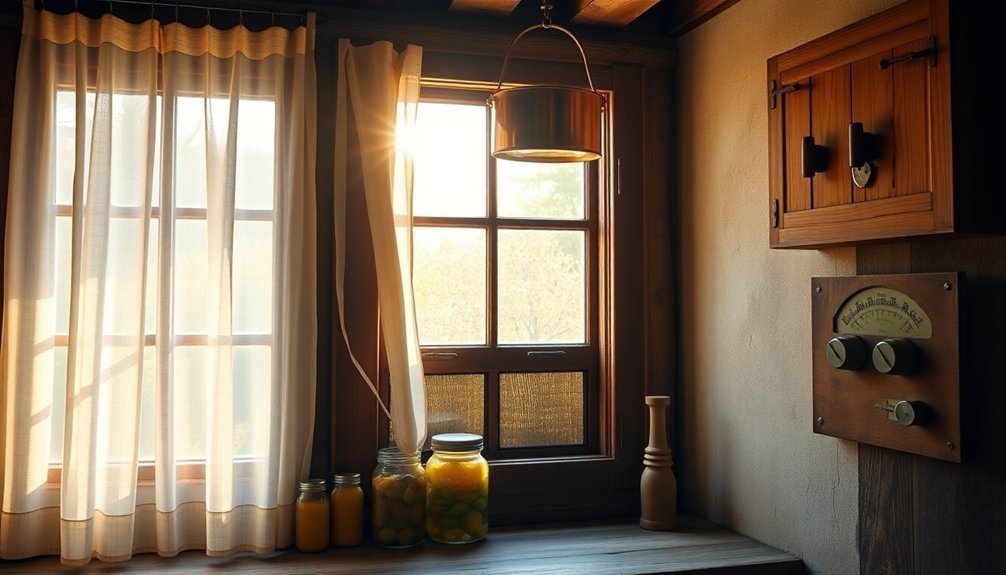
In your off-grid kitchen, you'll need to adapt your temperature control strategies as seasons change.
You can maximize winter warmth by integrating solar heat pumps with flash fires for morning cooking, while summer comfort relies on the same heat pumps operating in reverse for cooling. The reliable EG4 Solar A/C offers outstanding temperature control in both seasons.
During spring and fall, you'll benefit from a flexible approach that combines intermittent heating through wood cook stoves with solar assistance to maintain ideal kitchen temperatures.
Winter Heat Retention Methods
Maintaining a comfortable temperature in off-grid kitchens during winter requires strategic planning and multiple heating solutions. You'll need to combine efficient heating methods with smart insulation techniques to create a warm, functional cooking space.
| Heat Source | Application |
|---|---|
| Woodstove | Primary heating and cooking |
| Propane Stove | Reliable backup cooking |
| Solar Heat Pump | Dual heating/cooling |
| Radiant Heater | Spot heating |
To maximize heat retention, insulate your windows with heavy quilts and block door drafts with rolled towels. You'll find that insulated cookware helps maintain food temperatures while conserving energy. Don't forget to protect your water system – heat-tape exposed pipes and keep water pumps warm with heat lamps connected to thermostats. For ideal energy management, use programmable thermostats to regulate temperatures when you're not actively cooking. Consider installing high-R-value insulation in your kitchen walls to significantly reduce heat loss during the coldest months.
Summer Cooling Strategies
While summer heat can challenge off-grid kitchen operations, you'll find several effective strategies to keep your cooking space comfortable and functional.
Start by maximizing ventilation through RV roof vents and strategically placed fans to push hot air out while drawing cooler air in. Install shade tarps or reflective covers over your kitchen area, and apply reflective materials on south-facing surfaces.
For food storage, utilize a dual-zone fridge and insulated containers. You'll want to keep drinks cool by storing water bottles in the freezer and using quality thermoses.
Adapt your cooking methods by opting for outdoor solutions like solar ovens or slow cookers, which generate less indoor heat. When possible, prepare meals during cooler periods and choose recipes that require minimal cooking time.
These approaches will help maintain a comfortable cooking environment throughout the summer months.
Spring-Fall Transitional Temperature Control
Seasonal changes demand flexible temperature control strategies for your off-grid kitchen's comfort and functionality. You'll need to adapt your cooking methods and equipment as temperatures fluctuate during spring and fall months.
| Season | Temperature Control | Equipment Needs |
|---|---|---|
| Spring | Monitor daily temps | Solar heat pump |
| Summer | Minimize heat output | Insulated containers |
| Fall | Increase heat sources | Dutch oven, propane |
To maintain ideal cooking conditions, you'll want to use propane stoves for consistent heat output and insulated cookware to retain warmth. Don't forget to create wind barriers around your cooking area and maintain a well-built fire for both cooking and ambient warmth. Store your ingredients in insulated containers and organize your setup efficiently to minimize exposure to temperature fluctuations. Remember to check food temperatures with a reliable thermometer as cooking times may vary with weather changes.
Essential Temperature Monitoring Tools
Because off-grid kitchen success depends on precise temperature control, you'll need reliable monitoring tools to maintain food safety and operational efficiency.
Today's remote temperature sensors offer battery-powered convenience with up to two years of operation on standard AA batteries, making them perfect for off-grid setups.
- Durable sensors withstand extreme temperatures and moisture while providing real-time monitoring through your mobile devices
- Automated data logging eliminates manual record-keeping and helps maintain HACCP compliance
- Customizable alerts notify you instantly when temperatures deviate from safe zones, allowing quick corrective action
- Multiple probe options let you monitor various equipment types, from freezers to bread proofers
These tools integrate seamlessly with extensive kitchen systems, helping you maintain consistent temperatures and food safety standards, even in remote locations.
Food Placement and Heat Distribution
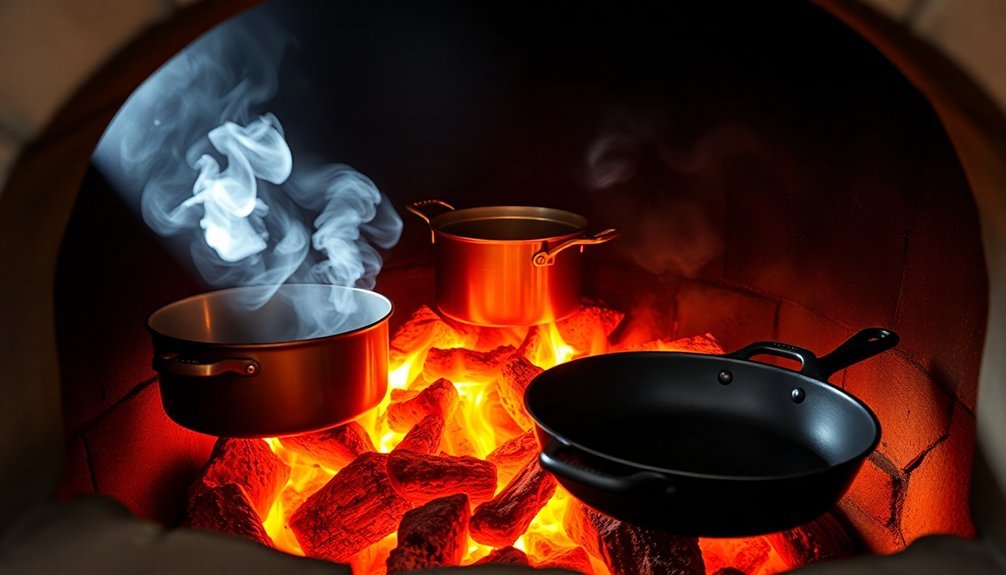
Since proper food placement directly impacts cooking efficiency in off-grid kitchens, mastering heat distribution techniques is essential for success.
Position your food in the center of the cooking area and avoid overcrowding to guarantee even heating. You'll get the best results by using cast iron pans or Dutch ovens, which excel at heat retention.
For ideal heat distribution, consider your heating source carefully. Bottom-mounted elements allow heat to rise naturally, while convection units use fans to circulate hot air evenly.
If you're using a wood-burning stove, position food to avoid direct flame contact and utilize grates for better oxygen flow.
Solar ovens require wrapping food in foil for extra insulation, while thermal cookers can maintain warmth for hours without additional power sources.
Weather Impact on Cooking Times
Your off-grid cooking methods need significant adjustments as seasons change, with winter requiring longer cooking times and additional fuel to maintain steady temperatures.
You'll find that high humidity speeds up cooking while cold, dry conditions slow it down, making weather monitoring essential for perfect results.
When cooking outdoors, you must account for wind and precipitation by using insulated cookware and windbreaks to maintain consistent heat levels.
Seasonal Cooking Adjustments
Weather conditions play an essential role in off-grid cooking times and techniques throughout the year.
You'll need to adapt your cooking methods based on seasonal changes, particularly when using solar cooking equipment. During summer months, you can enjoy longer unattended cooking periods, while winter requires more frequent adjustments and monitoring.
- Plan your meals around peak sunlight hours (11:00 am – 3:00 pm) for ideal solar cooking results
- Use propane stoves and insulated cookware during cold weather to maintain consistent temperatures
- Pre-prep ingredients at home to minimize exposure to harsh elements
- Protect your cooking area from wind by creating sheltered spaces
Remember to adjust your cooking techniques based on your location's climate.
Southern regions like Arizona and Texas offer more favorable conditions for solar cooking, while cloudy or rainy areas may require alternative cooking methods throughout the year.
Weather-Based Heat Retention
Understanding how atmospheric conditions affect cooking temperatures is essential for successful off-grid meal preparation. You'll need to adapt your cooking times based on weather variables that directly impact heat retention and distribution.
| Weather Condition | Required Adjustment |
|---|---|
| High Temperature | Reduce cooking time, monitor closely |
| High Humidity | Decrease time, expect faster cooking |
| Strong Winds | Add windbreaks, increase heat source |
| Low Temperature | Extend cooking time, use more fuel |
Your food will cook faster in humid conditions because moisture stays on the surface, while dry conditions require longer cooking times. At higher altitudes, you'll need to cook at lower temperatures for extended periods due to reduced atmospheric pressure. Remember to use insulated cookware in cold weather and maintain proper fire management through dry kindling and sheltered locations to guarantee consistent heating.
Reflector Angle Optimization
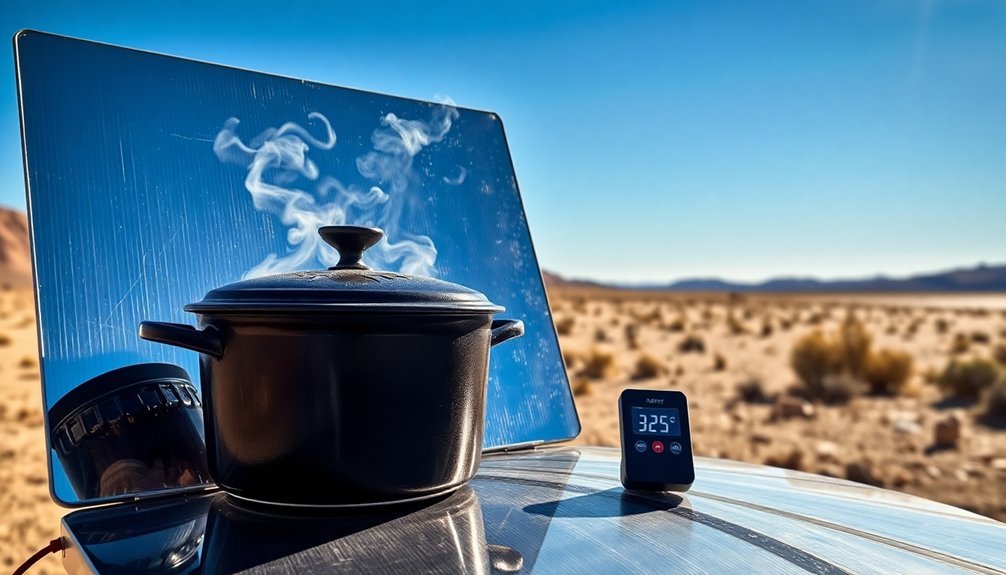
Proper angle adjustment of solar reflectors can make or break the efficiency of an off-grid kitchen setup. You'll need to verify your reflectors maintain at least 15° angular tolerance for reliable unattended cooking.
To maximize performance, position your reflectors to cuddle around your cookware, with the top reflector at a steep angle and the bottom at a shallow angle.
For peak results, consider these key adjustments:
- Use a protractor to measure angles precisely
- Position the rim farthest from the optical axis for equal tolerance
- Extend the reflector where it faces the pot cover
- Trim the reflector where it faces the pot bottom
Remember that moving your target in front of the reflector enhances capture area more effectively than simply increasing reflector length.
With a deep, dark pot, you'll achieve higher gain due to improved angular tolerance.
Multiple Dish Temperature Management
You'll need to strategically arrange your dishes across different cooking zones, whether using solar ovens, propane stoves, or thermal cookers, to maintain ideal temperatures for each item.
Your kitchen thermometers and temperature probes can work together to track multiple dishes simultaneously, letting you know when each reaches its target temperature.
Smart device integration through tools like the GoSun Thermo helps you manage heat levels across various cooking methods, ensuring everything from slow-cooked stews to quick-heated sides comes out perfectly timed.
Zone Cooking Heat Distribution
Mastery of zone cooking heat distribution transforms an off-grid kitchen into an efficient cooking hub where you can manage multiple dishes at different temperatures simultaneously.
By understanding heat transfer methods, you'll optimize your cooking zones to maximize energy efficiency and cooking results.
- Position high-heat dishes closer to your heat source where conduction and radiation are strongest.
- Create convection zones by arranging items at different heights, letting hot air circulate effectively.
- Utilize material properties by placing quick-cooking items in metal containers and slower-cooking items in ceramic vessels.
- Set up your triangular kitchen layout to support different temperature zones, keeping hot and cold areas separate.
Remember that heat distribution isn't just about temperature – it's about using the right combination of conduction, convection, and radiation for each cooking method in your designated zones.
Concurrent Temperature Monitoring Systems
While cooking multiple dishes in an off-grid kitchen presents unique challenges, implementing a reliable temperature monitoring system guarantees consistent results and food safety.
You'll want to choose a wireless monitoring system with multiple probes that can track several dishes simultaneously. These systems typically run on long-lasting batteries, making them perfect for off-grid setups.
Look for monitors that offer real-time temperature readings and customizable alerts. You can set specific thresholds for different dishes, and the system will notify you when temperatures drift outside safe zones.
Most modern units can handle up to three probes at once, letting you track your main dish, sides, and warming areas without constant checking. The durable design of these monitors assures they'll withstand harsh kitchen conditions while providing accurate readings consistently.
Smart Device Heat Management
Managing multiple dishes effectively in an off-grid kitchen becomes seamless with smart device heat management systems. With the iQ Sense Smart Thermometer's multi-probe functionality, you'll monitor up to three dishes simultaneously while maintaining precise temperature control.
The system's real-time monitoring and temperature graphing features let you track cooking progress effortlessly, even during slow-cooking methods.
- Set customizable alerts to notify you when temperatures stray from safe zones
- Monitor your dishes remotely through smartphone or tablet integration
- Track temperature changes during the significant resting period
- Access historical data to improve your cooking techniques over time
You won't need to worry about power consumption either, as the system operates for up to two years on standard AA batteries, making it ideal for off-grid cooking environments.
Safety Temperature Guidelines
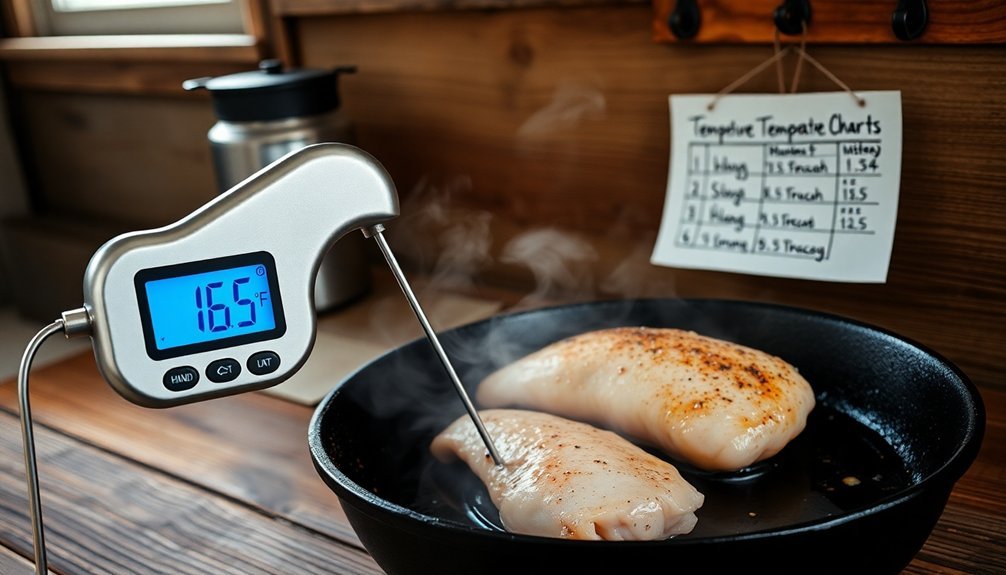
Safe food handling in off-grid kitchens requires strict adherence to temperature guidelines. You'll need to monitor your food storage temperatures carefully, keeping your refrigerator at or below 40°F and your freezer at 0°F or lower. Don't let perishables sit in the danger zone between 41°F and 135°F for more than 4 hours.
| Temperature | Food Safety Action | Time Limit |
|---|---|---|
| Above 135°F | Keep hot foods here | Continuous |
| 41°F-135°F | Danger Zone | 4 hours max |
| Below 41°F | Keep cold foods here | Continuous |
If you're using alternative cooling methods, like ice packs or coolers, check food temperatures regularly. When cooling hot foods, they must go from 135°F to 70°F within 2 hours, then reach 41°F within 4 more hours. Remember, if you're ever in doubt about food safety, it's better to discard the item.
Tracking Solar Movement
Solar tracking systems can dramatically boost your off-grid kitchen's power generation by following the sun's daily and seasonal movements.
You'll find two main types: single-axis trackers that improve output by 25% and dual-axis systems that boost performance by 40%.
To build your own tracker, you'll need:
- An Arduino Uno board as the system's brain
- Light-dependent resistors to detect sunlight intensity
- Servo motors or linear actuators for panel movement
- Basic materials like treated lumber or angle iron for the frame
The system works by comparing light readings from sensors mounted on both sides of your panels.
Your Arduino processes these readings and directs the servo to adjust panel positioning. At night, it'll automatically reset to face east, ready for the next sunrise.
This precise tracking guarantees maximum solar exposure throughout the year.
Maintaining Consistent Heat Levels
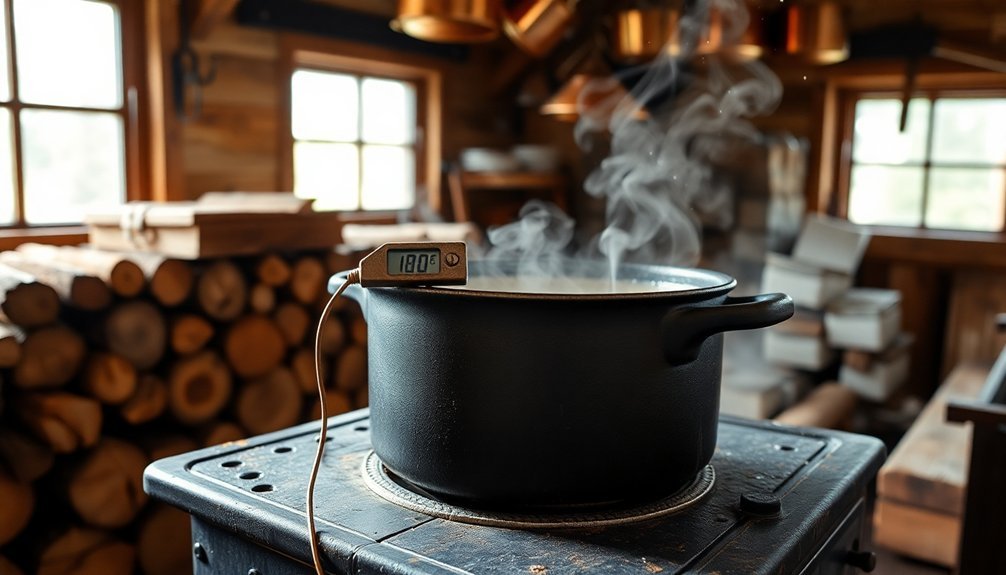
When cooking off-grid, maintaining consistent heat levels presents unique challenges that require careful attention to both your heat source and surrounding conditions.
You'll need to match your cookware carefully to your chosen heat source, whether you're using propane, open fires, or solar cooking methods. Set up windshields to protect your flames from gusts, and always cook on stable, non-flammable surfaces.
For ideal temperature control, consider using insulated cookers or thermal retainers that help maintain steady heat despite weather changes.
To conserve fuel while maintaining consistent temperatures, try steam cooking methods or retained heat cooking techniques. You can maximize efficiency by choosing energy-efficient cookware and refining your recipes for slow-cooking methods.
Remember to monitor weather conditions and adjust your cooking setup accordingly to guarantee reliable, even heating throughout your meal preparation.
Frequently Asked Questions
Can I Use Propane and Solar Cooking Systems Simultaneously for Better Temperature Control?
Yes, you can use both systems together! You'll get precise temperature control by running your propane stove for quick, high-heat cooking while your solar oven handles slower-cooking dishes at lower temperatures simultaneously.
How Do Different Altitudes Affect Temperature Readings in Off-Grid Cooking Methods?
At higher altitudes, you'll notice lower boiling points and faster evaporation rates. Your thermometer readings will stay accurate, but you'll need to adjust your target cooking temperatures based on your elevation's boiling point.
What Backup Temperature Monitoring Systems Work Without Batteries or Solar Power?
You can rely on traditional mercury thermometers, mechanical dial thermometers, or V2L-powered digital displays from your EV. Generator-backed monitoring systems and grid-connected devices offer reliable alternatives when other power sources fail.
Do Electromagnetic Fields From Solar Panels Interfere With Digital Temperature Monitoring Devices?
Yes, your solar panels' inverters can interfere with digital temperature monitors through electromagnetic fields. You'll notice reduced accuracy and communication range, but you can minimize this by properly shielding devices and using EMI filters.
How Does Humidity Impact Temperature Consistency in Various Off-Grid Cooking Methods?
You'll find high humidity speeds up grilling but slows solar cooking. In earth ovens, it enhances steam cooking, while insulated methods aren't greatly affected. Monitor temperatures more closely when humidity's high to maintain consistency.
In Summary
You'll find that mastering temperature control in your off-grid kitchen takes practice and patience. Keep tracking your cooking patterns, monitor your food placement, and adjust for seasonal changes. With the right tools and careful attention to solar movement, you'll soon develop an intuitive understanding of heat management. Remember: consistent monitoring and small adjustments are key to achieving perfect off-grid cooking temperatures every time.

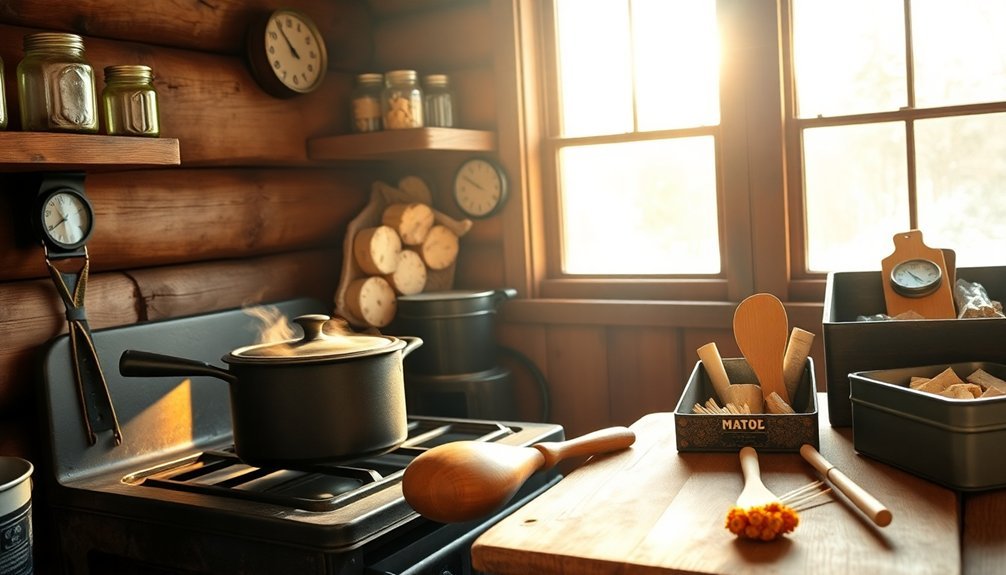



Leave a Reply